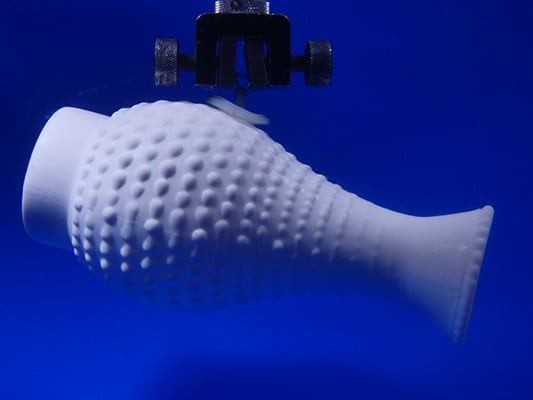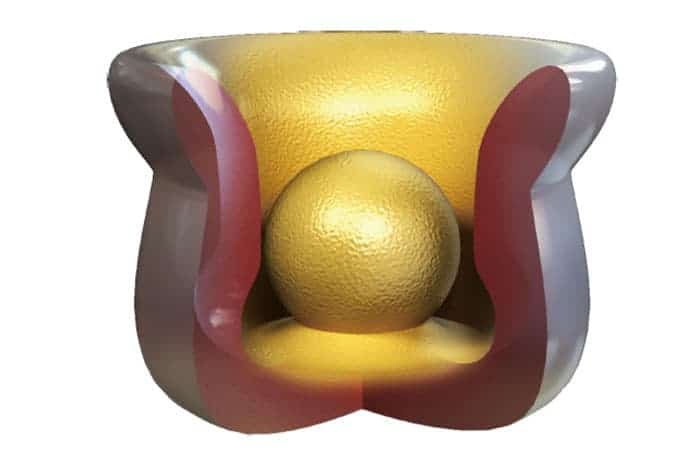
By mimicking how a tiny fish clings to rocks and other objects, researchers in California have made suction cups that adhere to rough surfaces in air and underwater. The team also showed how a robotic arm fitted with such a suction device can manipulate delicate objects such as a strawberry and a raw egg. They hope that their design could be used by deep-sea remotely operated vehicles (ROVs) for the recovery of fragile archaeological specimens and brittle marine samples.
Suction cups work well on smooth surfaces such as car windscreens, where the pressure difference they rely on can be maintained for a very long time. Rough surfaces are much more challenging because creating an effective seal is difficult.
Evolution has solved this problem for sea creatures that use natural suction cups to cling onto rugged rocks both above and beneath the waves. Trying to mimic these natural structures has long been an active area of research in soft robotics — however, scientists have only recently begun investigating the passive mechanism by which the northern clingfish avoids being tossed about by intertidal surges.
Michael Tolley’s soft robotics group at the University of California, San Diego, began to look at clingfish adhesion when PhD student and ROV pilot Jessica Sandoval shared her frustrations of gathering objects underwater.
Softness built in
“[ROVs] have rigid manipulators that don’t have much fine tune control,” said Tolley. “It started us thinking, can we do manipulation underwater with some softness built into the system to delicately handle things?”
Tolley struck up a collaboration with Dimitri Deheyn, a marine biologist at the Scripps Institution of Oceanography in nearby La Jolla. With Deheyn’s guidance, Sandoval dissected clingfish specimens from the Scripps’ extensive fish collection, and some fresh specimens collected along the San Diego coastline. They examined the structure of the clingfish’s suction cup using various optical techniques, identifying four core features likely to be involved in the adhesive strategies employed by the clingfish.
The team then studied how these features — slits, a soft sealing layer, microfibrils and the shape of the cup — impacted adhesion. They fabricated 25 mm diameter silicone suction cups, with different combinations of these features and tested them in different scenarios.
Secret to suction
The tests involved applying a relatively small force to attach a cup onto surfaces of varying roughness, both underwater and in the air. Then the force needed to remove the cup was recorded.
“The commercial suction cup always did better on flat surfaces, but with any sort of roughness our prototypes did much better. It’s an exciting start, but we’ve not yet reached the actual performance of the clingfish suction disc,” explains Tolley.
Different combinations of shape and slits performed better in water and air, but the soft sealing layer is essential for adhesive performance on rough surfaces below and above water.
Another feature thought to help clingfish maintain a seal on challenging rough surfaces, is the dense bed of microfibrils or “micropapillae”, which are tiny soft protuberances that line the cup perimeter. The team mimicked these micropapillae by adding silicone micropillars to their cups.
Somewhat surprised
“We were somewhat surprised the microstructures weren’t an improvement ……on the soft sealing layer,” said Tolley. “But we looked only at structure and material properties, while the clingfish has other features, like mucus secretion that could affect papillae adhesion.”
The team followed up these investigations by examining the impact of curved surfaces and analysing how slits in the suction cup enabled it to conform to concave surfaces.
The researchers then turned their attention to demonstrating what a suction cup could do by attaching it to the end of a robotic arm handling a variety of delicate fresh foods such as tomatoes, strawberries in the air. Tests were also done underwater, where the arm picked up several objects including a crab and a knobbly vase. Finally, with her pilot hat on, Sandoval used a ROV arm with a suction cup attachment to handle a raw egg without breaking it.
High pressure
Nicola Pugno at Italy’s University of Trento, who was not involved in the study, praised the team’s extensive investigations into suction cup performance in different scenarios. Pugno adds that he is intrigued to see how the suction cup, which relies on establishing a pressure differential for suction, would perform when subjected to the high pressures ROVs experience on the ocean floor.

Octopus-inspired adhesive could heal wounds
The team is keen to perform further underwater tests and plans to study live clingfish to find out how suction cups are actively altered according to the environment.
“I see these types of adhesive components as being a very specific piece of the puzzle that fits into a larger soft robotic system,” said Tolley, who hopes to combine adhesion with other work in his team on pneumatics and smart muscles, to create robots with greater utility.
The research is described in Bioinspiration & Biomimetics.



